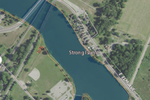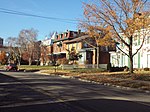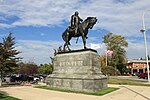River Raisin National Battlefield Park

The River Raisin National Battlefield Park preserves the site of the Battle of Frenchtown as the only national battlefield marking a site of the War of 1812. It was established as the 393rd unit of the United States National Park Service under Title VII of the Omnibus Public Land Management Act, which was signed into law on March 30, 2009. The park is located in the city of Monroe in Monroe County, Michigan. It was designated as a Michigan Historic Site on February 18, 1956 and was added to the National Register of Historic Places on December 10, 1982. The house at 1403 East Elm Avenue was added to the National Register listing in 2019. It officially began operation as a national park unit on October 22, 2010.
Excerpt from the Wikipedia article River Raisin National Battlefield Park (License: CC BY-SA 3.0, Authors, Images).River Raisin National Battlefield Park
River Raisin Heritage Trail,
Geographical coordinates (GPS) Address Nearby Places Show on map
Geographical coordinates (GPS)
| Latitude | Longitude |
|---|---|
| N 41.913611111111 ° | E -83.378333333333 ° |
Address
River Raisin Heritage Trail
River Raisin Heritage Trail
48162
Michigan, United States
Open on Google Maps











